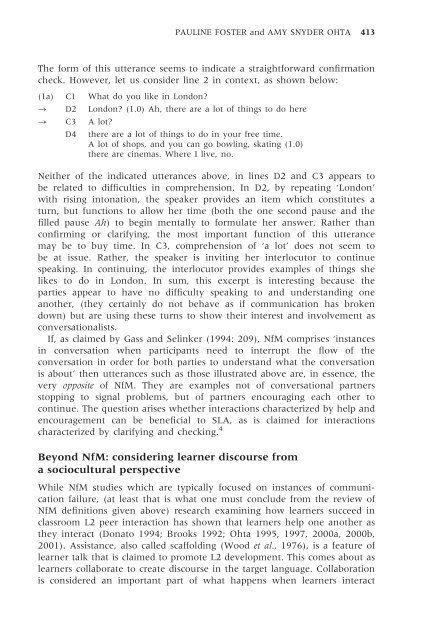Negotiation for Meaning and Peer Assistance in Second Language ...
Negotiation for Meaning and Peer Assistance in Second Language ...
Negotiation for Meaning and Peer Assistance in Second Language ...
You also want an ePaper? Increase the reach of your titles
YUMPU automatically turns print PDFs into web optimized ePapers that Google loves.
PAULINE FOSTER <strong>and</strong> AMY SNYDER OHTA 413<br />
The <strong>for</strong>m of this utterance seems to <strong>in</strong>dicate a straight<strong>for</strong>ward confirmation<br />
check. However, let us consider l<strong>in</strong>e 2 <strong>in</strong> context, as shown below:<br />
(1a) C1 What do you like <strong>in</strong> London?<br />
! D2 London? (1.0) Ah, there are a lot of th<strong>in</strong>gs to do here<br />
! C3 A lot?<br />
D4 there are a lot of th<strong>in</strong>gs to do <strong>in</strong> your free time.<br />
A lot of shops, <strong>and</strong> you can go bowl<strong>in</strong>g, skat<strong>in</strong>g (1.0)<br />
there are c<strong>in</strong>emas. Where I live, no.<br />
Neither of the <strong>in</strong>dicated utterances above, <strong>in</strong> l<strong>in</strong>es D2 <strong>and</strong> C3 appears to<br />
be related to difficulties <strong>in</strong> comprehension. In D2, by repeat<strong>in</strong>g ‘London’<br />
with ris<strong>in</strong>g <strong>in</strong>tonation, the speaker provides an item which constitutes a<br />
turn, but functions to allow her time (both the one second pause <strong>and</strong> the<br />
filled pause Ah) to beg<strong>in</strong> mentally to <strong>for</strong>mulate her answer. Rather than<br />
confirm<strong>in</strong>g or clarify<strong>in</strong>g, the most important function of this utterance<br />
may be to buy time. In C3, comprehension of ‘a lot’ does not seem to<br />
be at issue. Rather, the speaker is <strong>in</strong>vit<strong>in</strong>g her <strong>in</strong>terlocutor to cont<strong>in</strong>ue<br />
speak<strong>in</strong>g. In cont<strong>in</strong>u<strong>in</strong>g, the <strong>in</strong>terlocutor provides examples of th<strong>in</strong>gs she<br />
likes to do <strong>in</strong> London. In sum, this excerpt is <strong>in</strong>terest<strong>in</strong>g because the<br />
parties appear to have no difficulty speak<strong>in</strong>g to <strong>and</strong> underst<strong>and</strong><strong>in</strong>g one<br />
another, (they certa<strong>in</strong>ly do not behave as if communication has broken<br />
down) but are us<strong>in</strong>g these turns to show their <strong>in</strong>terest <strong>and</strong> <strong>in</strong>volvement as<br />
conversationalists.<br />
If, as claimed by Gass <strong>and</strong> Sel<strong>in</strong>ker (1994: 209), NfM comprises ‘<strong>in</strong>stances<br />
<strong>in</strong> conversation when participants need to <strong>in</strong>terrupt the flow of the<br />
conversation <strong>in</strong> order <strong>for</strong> both parties to underst<strong>and</strong> what the conversation<br />
is about’ then utterances such as those illustrated above are, <strong>in</strong> essence, the<br />
very opposite of NfM. They are examples not of conversational partners<br />
stopp<strong>in</strong>g to signal problems, but of partners encourag<strong>in</strong>g each other to<br />
cont<strong>in</strong>ue. The question arises whether <strong>in</strong>teractions characterized by help <strong>and</strong><br />
encouragement can be beneficial to SLA, as is claimed <strong>for</strong> <strong>in</strong>teractions<br />
characterized by clarify<strong>in</strong>g <strong>and</strong> check<strong>in</strong>g. 4<br />
Beyond NfM: consider<strong>in</strong>g learner discourse from<br />
a sociocultural perspective<br />
While NfM studies which are typically focused on <strong>in</strong>stances of communication<br />
failure, (at least that is what one must conclude from the review of<br />
NfM def<strong>in</strong>itions given above) research exam<strong>in</strong><strong>in</strong>g how learners succeed <strong>in</strong><br />
classroom L2 peer <strong>in</strong>teraction has shown that learners help one another as<br />
they <strong>in</strong>teract (Donato 1994; Brooks 1992; Ohta 1995, 1997, 2000a, 2000b,<br />
2001). <strong>Assistance</strong>, also called scaffold<strong>in</strong>g (Wood et al., 1976), is a feature of<br />
learner talk that is claimed to promote L2 development. This comes about as<br />
learners collaborate to create discourse <strong>in</strong> the target language. Collaboration<br />
is considered an important part of what happens when learners <strong>in</strong>teract














